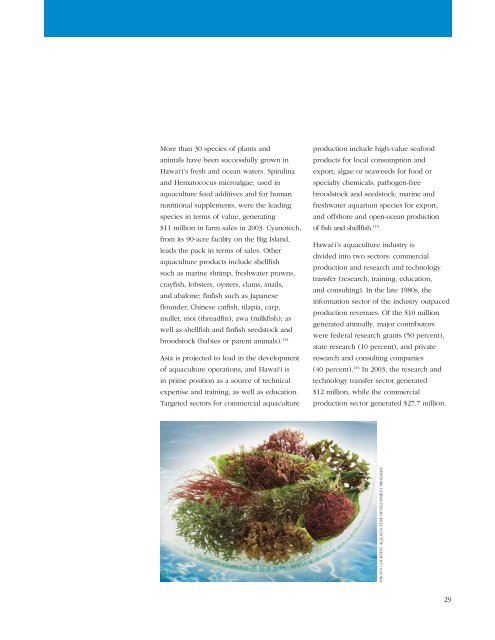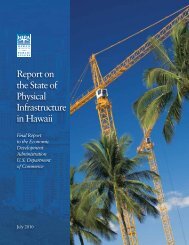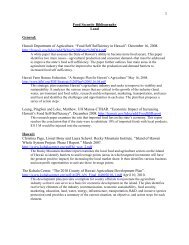Hawai'i Fisheries Initiative - The Hawaii Institute for Public Affairs
Hawai'i Fisheries Initiative - The Hawaii Institute for Public Affairs
Hawai'i Fisheries Initiative - The Hawaii Institute for Public Affairs
Create successful ePaper yourself
Turn your PDF publications into a flip-book with our unique Google optimized e-Paper software.
More than 30 species of plants and<br />
animals have been successfully grown in<br />
Hawai‘i’s fresh and ocean waters. Spirulina<br />
and Hematococus microalgae, used in<br />
aquaculture feed additives and <strong>for</strong> human<br />
nutritional supplements, were the leading<br />
species in terms of value, generating<br />
$11 million in farm sales in 2003. Cyanotech,<br />
from its 90-acre facility on the Big Island,<br />
leads the pack in terms of sales. Other<br />
aquaculture products include shellfish<br />
such as marine shrimp, freshwater prawns,<br />
crayfish, lobsters, oysters, clams, snails,<br />
and abalone; finfish such as Japanese<br />
flounder, Chinese catfish, tilapia, carp,<br />
mullet, moi (threadfin), awa (milkfish); as<br />
well as shellfish and finfish seedstock and<br />
broodstock (babies or parent animals). 114<br />
Asia is projected to lead in the development<br />
of aquaculture operations, and Hawai‘i is<br />
in prime position as a source of technical<br />
expertise and training, as well as education.<br />
Targeted sectors <strong>for</strong> commercial aquaculture<br />
production include high-value seafood<br />
products <strong>for</strong> local consumption and<br />
export; algae or seaweeds <strong>for</strong> food or<br />
specialty chemicals; pathogen-free<br />
broodstock and seedstock; marine and<br />
freshwater aquarium species <strong>for</strong> export;<br />
and offshore and open-ocean production<br />
of fish and shellfish. 115<br />
Hawai‘i’s aquaculture industry is<br />
divided into two sectors: commercial<br />
production and research and technology<br />
transfer (research, training, education,<br />
and consulting). In the late 1980s, the<br />
in<strong>for</strong>mation sector of the industry outpaced<br />
production revenues. Of the $10 million<br />
generated annually, major contributors<br />
were federal research grants (50 percent),<br />
state research (10 percent), and private<br />
research and consulting companies<br />
(40 percent). 116 In 2003, the research and<br />
technology transfer sector generated<br />
$12 million, while the commercial<br />
production sector generated $27.7 million.<br />
Photo courtesy Aquaculture Development Program<br />
29







